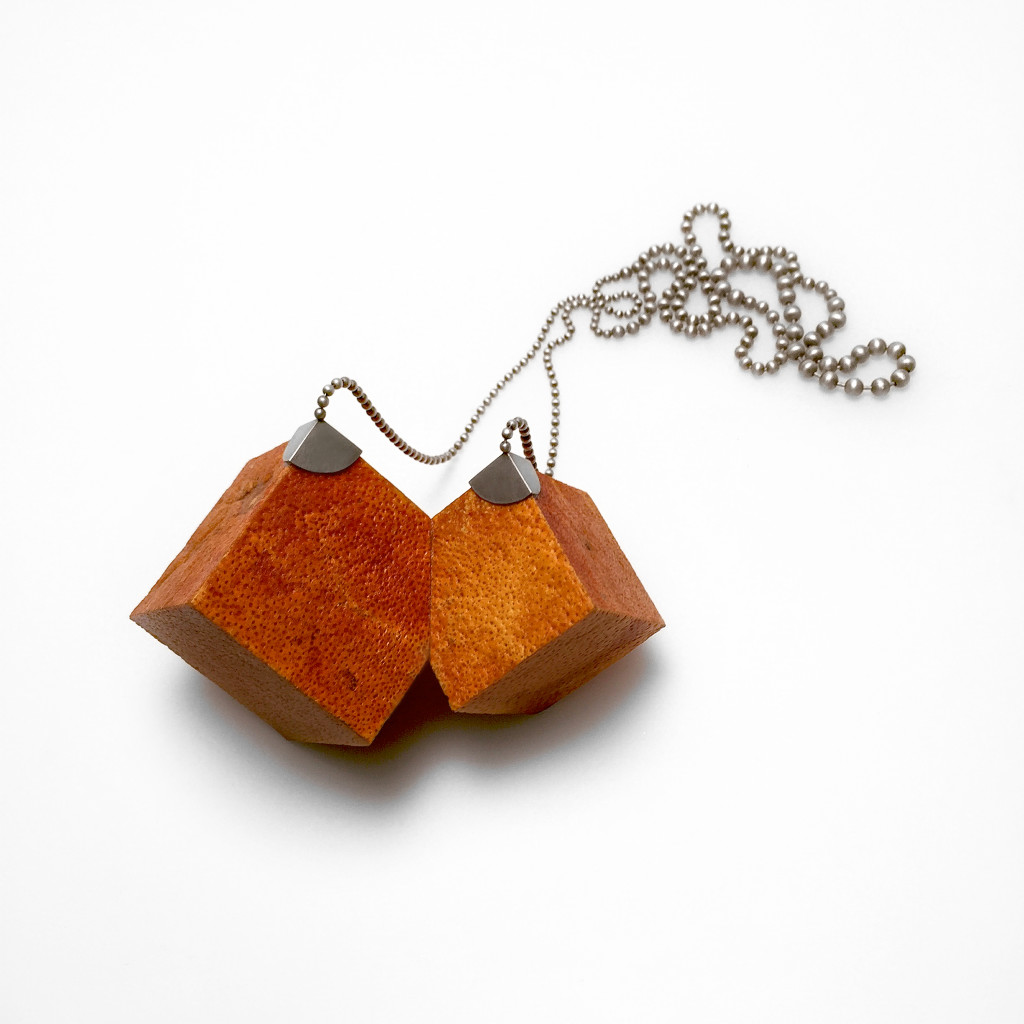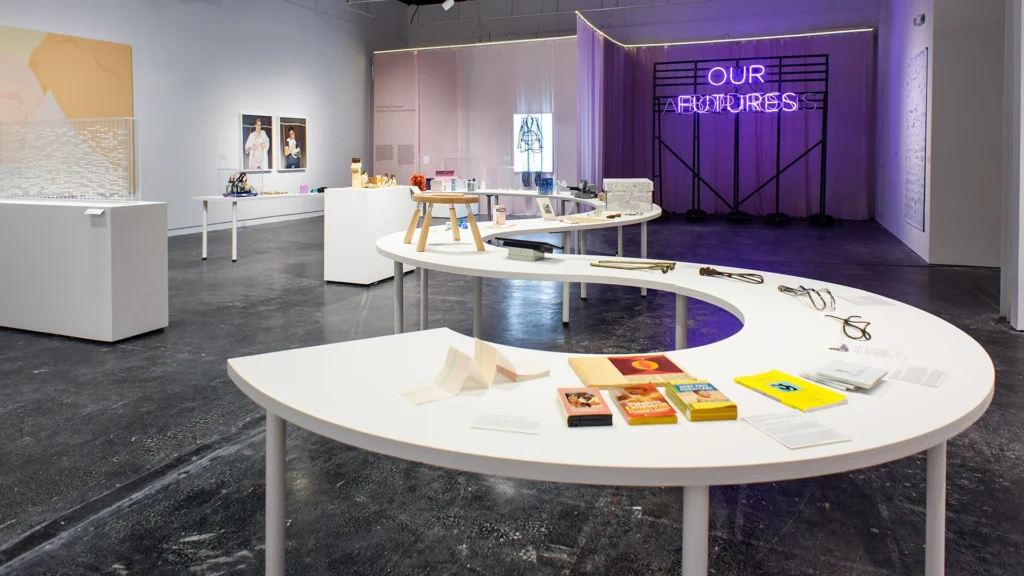Opening Reception & Artist Talk with Celia Butler
Saturday, September 10, 3:00 – 5:00 PMReception & Artist Talk with Kazuki Guzmán
Saturday, October 8, 3:00 – 5:00 PM
Houston Center for Contemporary Craft (HCCC) is pleased to present BEST IF USED BY, a group exhibition organized by HCCC Curatorial Fellow, Sarah Darro, that investigates the dynamic intersection of craft and food in contemporary culture. Featuring six U.S. and international artists, Celia Butler, Kazuki Guzmán, Joshua Kosker, Aurélie Mathigot, Yuka Otani, and Rachel Shimpock, this show aims to probe the very definitions of craft by staging critical comparisons among works that are moving at varying rates of consumption and deterioration. The works range in material from wool, ceramic, and electroformed metal to cast sugar, cured tangelo peels, and needle-worked bananas.
The fields of craft and artisanal food are simultaneously experiencing revitalization amid a renewed embrace of handmade culture. The term craft is often invoked in culinary and consumer contexts to denote quality and handmade production. The works in BEST IF USED BY investigate the entanglement of these worlds. Viewers are invited to examine the intersecting and diverging qualities of the displayed pieces, all of which possess a complex embodiment of tradition, specialized knowledge, process, culture, and artistry.
Otani and Guzmán both harness the fluidity and instability of organic material in their works, which investigate concepts of earthly delights and consumerism. Tokyo-based Otani is an esteemed glass artist who has incorporated working with melted sugar into her practice. She presents a new installation of cast-sugar Buddha figures that will slowly transcend their forms and melt over the course of the exhibition. Guzmán creates whimsical sculptural works that are activated by everyday materials, which range from embroidered meat to sculpted chewing gum. In BEST IF USED BY, he presents Vuitton Nana, a banana that he needle worked with the logo of the illustrious high-fashion brand.
Shimpock and Mathigot, on the other hand, suspend time. By rendering meals and place settings in traditional craft media, they capture the temporary nature of food and the communal moments garnered by sharing it. Shimpock is a metalsmith who fuses a history of ornamentation and personal adornment with foods that are meant to be consumed quickly and socially. Her electroformed french-fry bangles, gem-encrusted half-eaten donut, and brooches–inspired by what is left on the plate after eating–all make precious and lasting the fleeting, yet universal, act of eating. Mathigot is a Paris-based fiber artist whose crocheted installation works cast moments of everyday life, particularly those conducted in a domestic space, in a new, textile materiality. The artist presents four crocheted meals for this exhibition. Her meatloaf, birthday cake, sandwich, and burger with fries render not only the food items in fiber but also the disposable napkins, cups, and service ware associated with eating those foods.
Both Kosker’s and Butler’s works subvert the material construct of the cultural artifact by transforming and re-contextualizing everyday objects. Kosker is a metalsmith and jeweler whose works incorporate unexpected, found, half-used materials, from shoe soles to used bars of soap. The show will feature his Tangents series, a collection of stark, geometric jewelry forms veneered with Minneola tangelo rinds that he has cured, some even retaining their grocery stickers. His transformation of this organic, disposable material into precious bodily adornment marks the material itself as an artifact deemed worthy of preservation and contemplation. Butler is a mixed-media artist whose works in sugar explore notions of preservation and cultural consumption. For BEST IF USED BY, she presents a site-specific, sugar-encrusted installation that she conceives of as an unearthed artifact. The translucent, pristine candy coats a bucket, held by ropes, and transforms over time, crystallizing, becoming opaque, and, finally, melting.
Consumption is the overarching theme for the inquiries posed by this exhibition. Associated with the food industry, transience, and cultural value, this concept acts as a launching point for discourse about the interconnected nature of food and craft. Exhibiting works that exist on a spectrum of temporality, BEST IF USED BY allows for an exploration of the significance of the ephemeral in a field largely rooted in tangibility.
Image credits: (1) Celia Butler, “Sugar Gazing,” (installation), 2011. Sugar encrusted rope, bucket, and armature. Photo by P.D. Rearick. (2) Kazuki Guzmán, “Vuitton Nana,” 2008. Needlework on banana, 6 x 5 x 7 inches. Photo by Kazuki Guzmán. (3) Kazuki Guzmán, “Vuitton Nana” (detail), 2008. Needlework on banana, 6 x 5 x 7 inches. Photo by Kazuki Guzmán. (4) Joshua Kosker, “Cubic Tangelo Cluster” (pendant), 2016. Tangelo peel, plywood, sterling silver. 17 x 4 x 2 inches. Photo by Joshua Kosker. (5) Joshua Kosker, “Tips & Corners” (brooch), 2015. Laser cut 4384 minneola, .925 sterling silver, 304 stainless steel, faceted stone. 1 1/2 x 3 x 1/2 inches. Photo by Joshua Kosker. (6) Aurélie Mathigot, “J’aime pas la viande, ni les dimanches,” 2004. Crochet, wool thread, cotton, wrex. 17 x 30 cm. Photo by Aurélie Mathigot. (7) Aurélie Mathigot, “Pic-Nic,” 2006. Crochet, wool thread, cotton, wrex. 28 x 42 cm. Photo by Aurélie Mathigot.

